Creating a Ripple Effect: NC State Extension Helps Save Streams
go.ncsu.edu/readext?1066925
en Español / em Português
El inglés es el idioma de control de esta página. En la medida en que haya algún conflicto entre la traducción al inglés y la traducción, el inglés prevalece.
Al hacer clic en el enlace de traducción se activa un servicio de traducción gratuito para convertir la página al español. Al igual que con cualquier traducción por Internet, la conversión no es sensible al contexto y puede que no traduzca el texto en su significado original. NC State Extension no garantiza la exactitud del texto traducido. Por favor, tenga en cuenta que algunas aplicaciones y/o servicios pueden no funcionar como se espera cuando se traducen.
Português
Inglês é o idioma de controle desta página. Na medida que haja algum conflito entre o texto original em Inglês e a tradução, o Inglês prevalece.
Ao clicar no link de tradução, um serviço gratuito de tradução será ativado para converter a página para o Português. Como em qualquer tradução pela internet, a conversão não é sensivel ao contexto e pode não ocorrer a tradução para o significado orginal. O serviço de Extensão da Carolina do Norte (NC State Extension) não garante a exatidão do texto traduzido. Por favor, observe que algumas funções ou serviços podem não funcionar como esperado após a tradução.
English
English is the controlling language of this page. To the extent there is any conflict between the English text and the translation, English controls.
Clicking on the translation link activates a free translation service to convert the page to Spanish. As with any Internet translation, the conversion is not context-sensitive and may not translate the text to its original meaning. NC State Extension does not guarantee the accuracy of the translated text. Please note that some applications and/or services may not function as expected when translated.
Collapse ▲It’s simple physics. When water exceeds the capacity of its channel — a stream, a river, a drainage ditch — it will spill over and seek new avenues. Water will always take the path of least resistance, often going where it is not wanted.
Water always wins.
The destructive force of water is well known to the people of North Carolina, of course. Tropical storms are almost an annual occurrence on the coast. Just last year, Hurricane Helene caused unprecedented flooding in the mountains.
Urban landscapes are not immune. Heavy rains coupled with an abundance of impervious surfaces create flash floods, inundating streets and yards. Cities have streams and ditches designed to contain rainwater, but banks break down under water pressure.
“About 300 people move to North Carolina every day. There’s a lot of construction, a lot of impervious areas,” said Mitch Woodward, NC State Extension expert in water resources.
As farms and forests are replaced by buildings and roads, stormwater has fewer places to naturally absorb into the ground. Instead, that runoff flows into nearby streams, overwhelming the banks and accelerating erosion.
“The number one pollutant in urban areas in North Carolina is sediment, and the number one source of sediment is degraded streams,” Woodward said.
Extension Steps In
One of Woodward’s primary programs is repairing those streams, to make sure the water and the sediment are going where they are supposed to go.
“Stakeholders have asked for it. ‘How do we fix streams? Do we need an engineer here?’ Maybe. Maybe not,” he said.
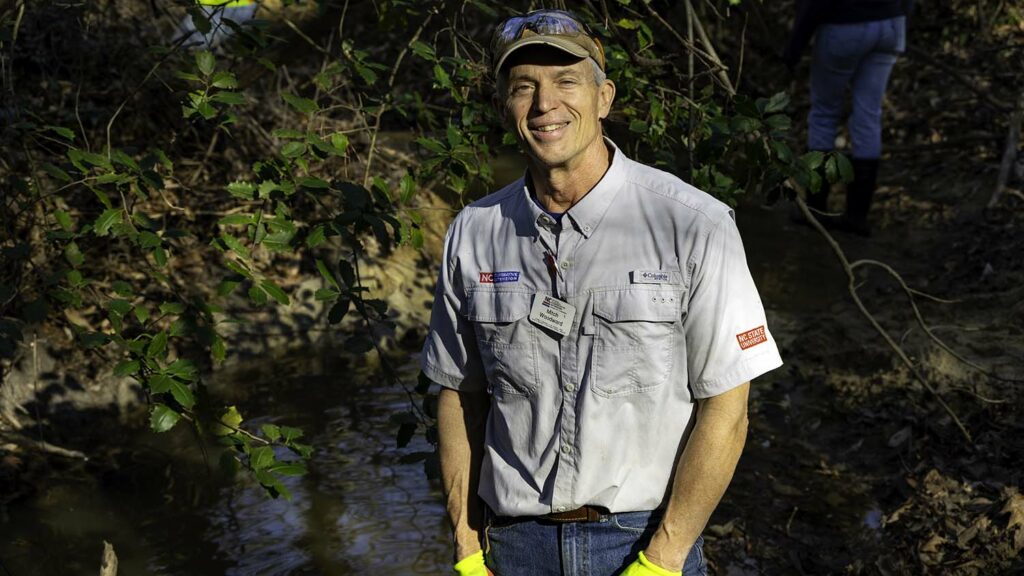
Mitch Woodward, NC State Extension area specialized agent for watersheds and water quality, teaches workshops in stream bank repair across the state.
Woodward is an area specialized agent who serves Extension’s 101 local centers. He travels across the state to conduct workshops in stream bank repair.
“What we showcase are simple, easy techniques with natural materials and plants that we can use to fix the stream without requiring a permit,” he said. “It’s very cost effective. It works. This is kind of a niche that we’ve developed over the last 20 years, 25 years.”
In his early years, Woodward’s work was concentrated on the Neuse River Basin, training farmers on nutrient management to keep pollutants out of the waterways. His programming expanded after attending a symposium in Charlotte with scientists and N.C. Department of Transportation engineers.
“We found stream bank restoration, and we found stormwater,” he said. “There was a lot of interest. Bill Hunt in biological and agricultural engineering is our stormwater lead. He’s working in the upper watershed, trying to catch it before it gets to the stream. We’re working on the bottom end, trying to keep it in the stream.”
Restoring Streams, Making Waves
His workshops consist of a classroom portion in the morning, followed by hands-on work repairing a stream in the afternoon.
“This is similar to a skilled trade,” he said. “I can show you how to lay bricks or repair a car engine on a set of slides. But to really learn it, you have to get hands-on.”
Woodward employs an effective Extension model of training the trainers. Every workshop includes landscape professionals, municipal stormwater employees, and others who can pass on the knowledge they’ll be soaking up.
“We have engineers, we have property managers, we have teachers, educators, land owners,” Woodward said. “We might train 400, 500 people in a year. They train other people, and it just mushrooms.”
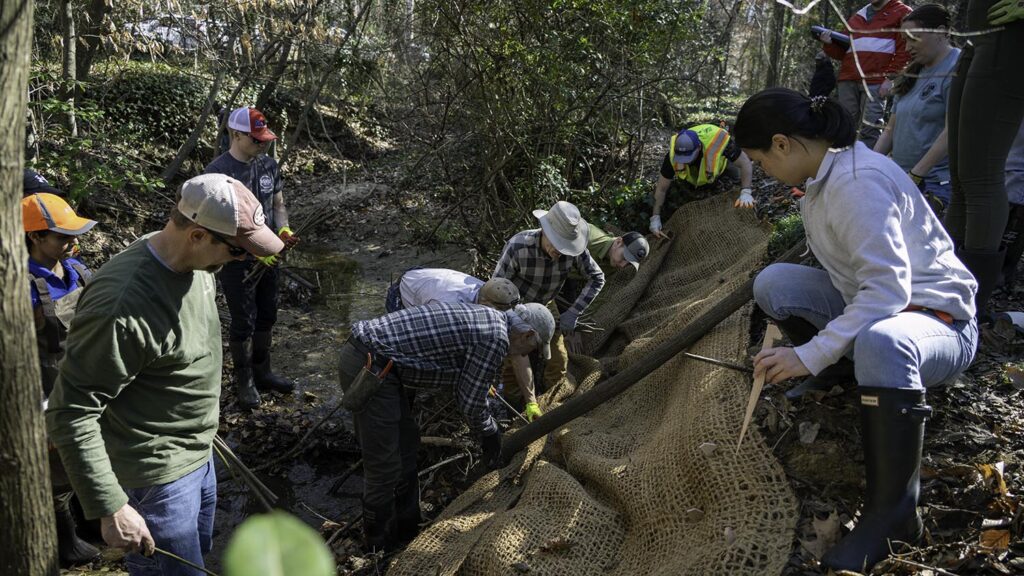
Participants in an NC State Extension stream bank repair workshop in Raleigh practice the techniques they learn. Many pass the skills on to others, multiplying the impact.
Every participant who passes a classroom test and participates in the hands-on portion receives certification as a stream bank repair professional.
“That’s something they can put on their business card, certified by NC State,” Woodward said. “They’ve got some ideas, some skills they can use, and also access to our materials website.”
In early spring, Woodward taught an urban water management course at a small city park in Raleigh. In conjunction with Dominick Smalls, a project manager with the city’s engineering services department, Woodward demonstrated techniques to strengthen a stream bank to prevent erosion.
“They had a blown out area in the stream after some heavy rains, so we’re going to stabilize it,” Smalls said.
The stream ran parallel to a street in a residential neighborhood. Its purpose was stormwater runoff. Repairing the bank was important to keep the water from spilling over into the surrounding streets and houses.
“This is a typical urban stream,” Woodward said. “There are lots of impervious areas. Heavy rains create flash floods through here. As development has increased in Raleigh and Wake County, a lot more stormwater flows off. For every football-field sized area, which is about an acre, there are 27,000 gallons of water in a one-inch storm. And it rains 45 to 50 inches a year.”

Dominick Smalls, center, a project manager with Raleigh’s engineering services department, participates in a stream bank repair workshop. The city has been partnering with NC State Extension on similar projects for four years.
Extension has been partnering with Raleigh since Smalls attended a workshop a few years ago.
“We’ve been working together for about four years,” Smalls said. “I came to one of his workshops and I knew the city of Raleigh can benefit from using those techniques on stormwater projects. We take a look at those projects. We assess them and if they’re good for a workshop, we’ll contact Mitch and say, ‘Hey, do you want to partner on this?’”
The question of whether a permit is required is an important consideration. Major repairs that involve heavy equipment and permissions from state or local authorities can significantly add to the cost.
“In North Carolina, you own the land but not the water,” Woodward said. “Certain regulations control water and streams. The Army Corps of Engineers can get involved. The Division of Environmental Quality can get involved. If you’re doing in-stream structures or other restoration projects, you need to involve them.”
Big Impact, Low Cost
Woodward’s workshops showcase techniques using natural and cost-effective materials including coir matting — mats composed of 100% natural fibers — hardwood stakes, live stakes, natural plants, rush mattresses, and bendable corner logs made from coconut fiber.
“If you go through contracting and design and use consulting, you’re talking about a $200,000 project,” Smalls said. “This is more like a $1,500 project to get all the materials out and to use volunteer labor. It’s good for our department, it’s good for the city. It’s saving taxpayer money for us to do it this way.”
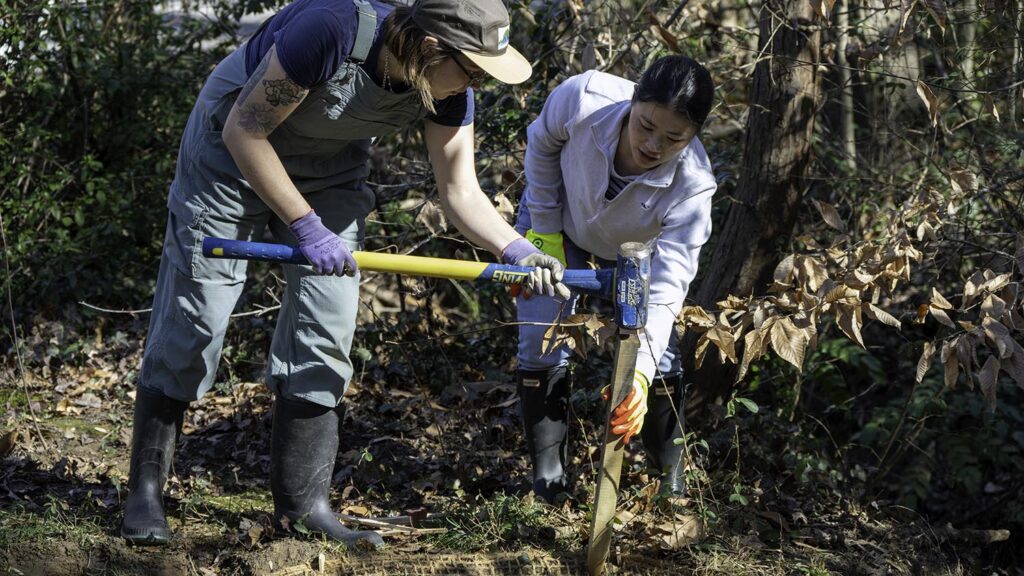
Participants in an NC State Extension stream bank repair workshop in Raleigh learn how to use natural materials, such as coir matting composed of coconut fibers, to strengthen a bank and help keep stormwater flowing through the channel.
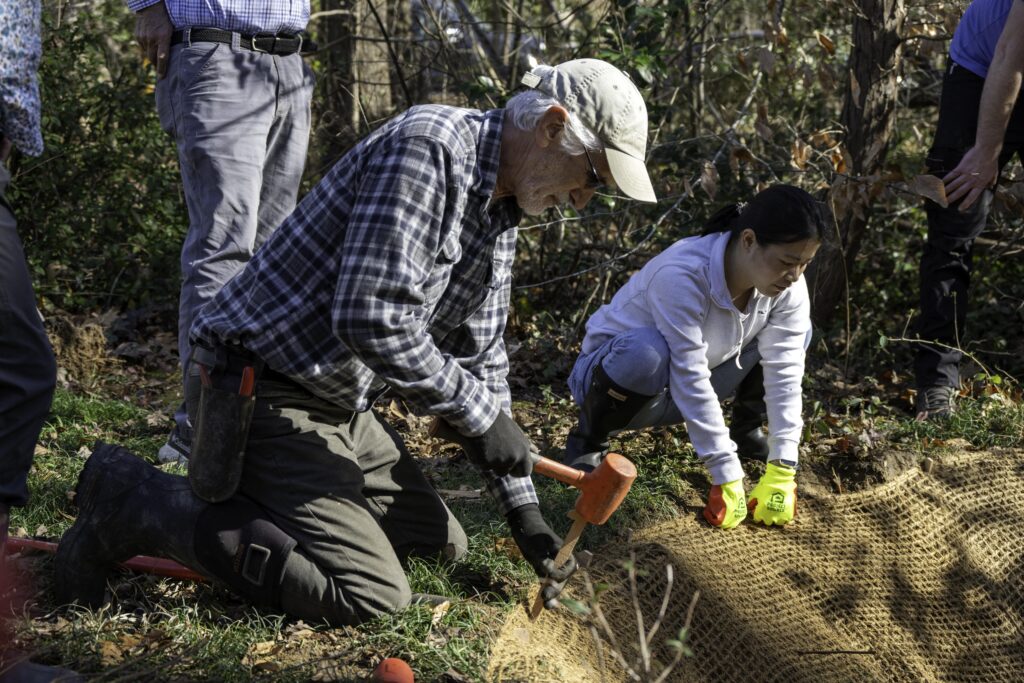 The partnership with Extension ensures the repairs are not only cost effective, but also that the work is high quality and meets all applicable standards.
The partnership with Extension ensures the repairs are not only cost effective, but also that the work is high quality and meets all applicable standards.
“We show them how to do this work while making sure they’re following all the federal and state rules and regulations,” Smalls said. “We let these homeowners know who to contact if they want to talk about what they’re doing.”
The Raleigh workshop attracted a mix of municipal employees, professional landscapers, nonprofit workers, and volunteers interested in environmental projects, all eager to learn the stream bank repair techniques.
They included Katie McClean, a project coordinator for the Cary-based Carolina Wetlands Association.
“We partner with organizations to work on wetlands restoration projects, especially flood mitigation issues,” she said. “We’re looking at several projects right now where we’re planning to do restoration of streams. Some of the techniques here are super helpful for me to know. Learning all the different plant species that they use to establish the bank here is really useful too. I work with a lot of volunteers and I work with the community, so some of what I’m learning I’m going to take and teach other people too.”
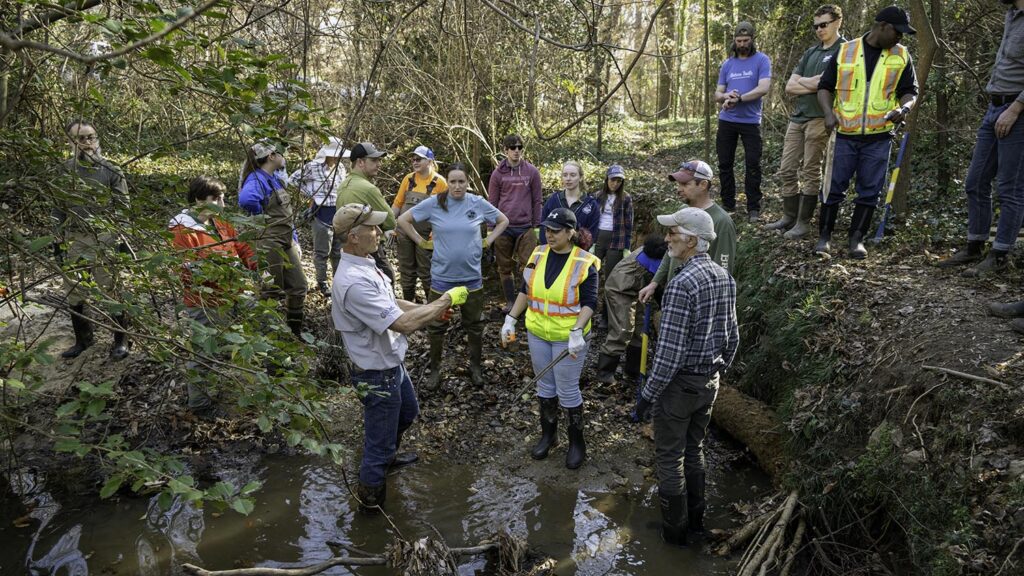
NC State Extension stream bank repair workshop participants have to be prepared to get their boots dirty.
The skills learned will help Robert McCaskill in his business. He works for Nature Trails, a company that designs and constructs trails for hikers, bikers and equestrians.
“I took a surface water identification certification course with the Extension program. Through that, we learned about this course and thought it would be an awesome thing to have in our portfolio,” said McCaskill, who graduated from NC State in 2011 with an education degree. “We cross streams and deal with property owners. This is something we can offer to help mitigate problems that we see in the field. We’ll get a better understanding of what the acceptable standard is and we’ll have a much better idea of what might need permits, so we can budget for that.”
Claire Hansen attended the workshop to learn techniques she can use on her job. She works on stormwater management programs as a stormwater technician with the city of Hillsborough.
“We have a few stream restoration projects or just spaces that need to be improved. I came out here so I could learn some more efficient ways to do that,” said Hansen, who is also a landscape design student at NC State.
Avoiding the expense of using heavy equipment that would require going through the permitting process is one reason why Brian Mayell attended the workshop. He serves on the Hillsborough Tree Board, and is a member of a volunteer group that is making improvements to the Eno riverbank.
“With some of these really vertical stream banks, if you don’t have the option of coming in and doing grading and engineering with the backhoe, what can you do?” he said. “This is great to see the work that they’re demonstrating with the coir mats. If you want to learn, this is the way to go. You’ve got people teaching and then you go out and do the field component. It’s perfect.”
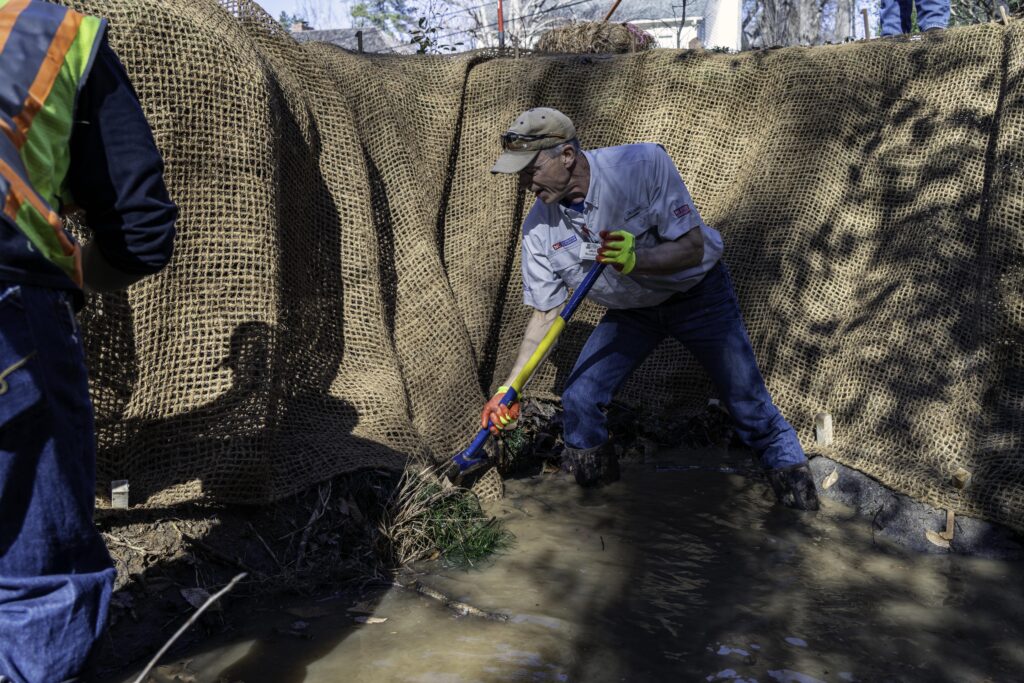
NC State Extension expert Mitch Woodward demonstrates how to repair a stream bank using natural, low-cost materials. Strengthening the bank helps mitigate the chance of flooding after heavy rains.
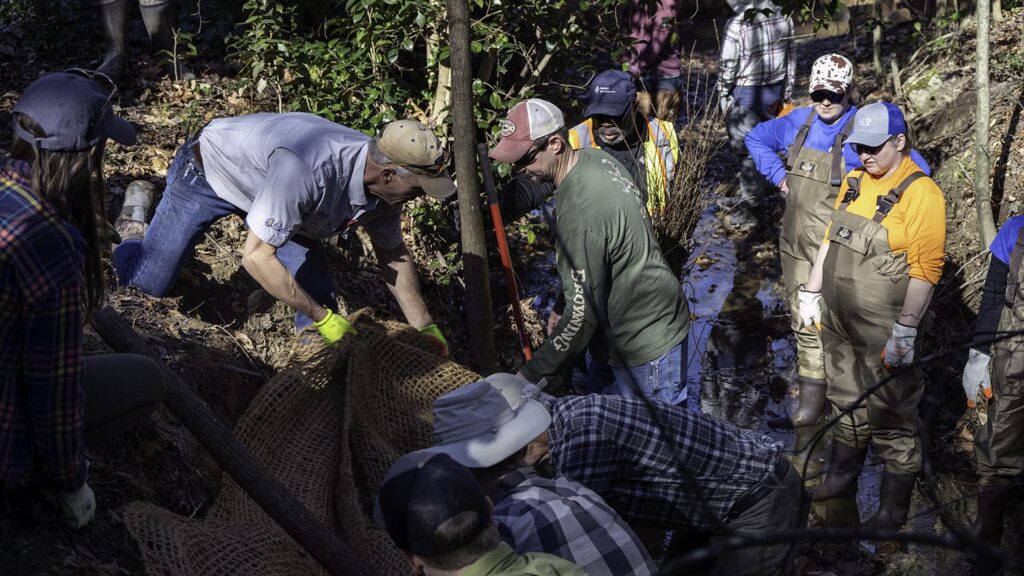 Woodward’s Raleigh workshop class even included another Extension agent. Paige Patterson, who holds a Master of Environmental Assessment degree from NC State, has been teaching about water resources in Watauga County. She came to get a refresher on restoration techniques and to obtain the certification.
Woodward’s Raleigh workshop class even included another Extension agent. Paige Patterson, who holds a Master of Environmental Assessment degree from NC State, has been teaching about water resources in Watauga County. She came to get a refresher on restoration techniques and to obtain the certification.
“I’m doing a class on stream restoration, and then I’ll have a second class where we will go out and do this along the Middle Fork greenway,” she said. “So I just thought I’d come down here and get the actual certification and see how he ran the course so it’d be fresh on my mind.”
She began her series of classes before Hurricane Helene flooded the mountains in late September 2024. The issue of stream bank restoration became much more important after the storm.
“It was very timely that I had a group of about 15 people that already understood the buffers and restoration, and had seen some of the projects,” she said.

